Author: Rosie Pugh, Content Marketing Manager, Passion Digital
There tend to be two stereotypes of the professional writer online. On one hand, there are poets and storytellers who want to express their creativity and would never dream of sacrificing art for something as crass as optimisation. On the other hand, there are copywriters who are slaves to the corporate machine and write only to appease the Google algorithm.
Personally I found myself drawn to the digital marketing industry because of its scope for creativity. I have always been a creative writer, and I saw a career in content marketing as a chance to flex my creative muscles. I was not disappointed; good SEO copywriting is an art form.
Applying SEO to Poetry
Recently I have come across a number of comments on poetry blogs and online forums bemoaning the evil of SEO writing. Why should we pander to the Google algorithm to get our poetry found? they cry self-righteously. How can I possibly maintain the quality and integrity of my writing if I’m optimising it for search engines?
So I set myself a challenge – is it possible to write SEO-friendly poetry? Can you use search intent modelling as a basis for creating something that stands up as a poem in its own right, but also has a fighting chance of ranking for relevant search terms?
I believe there is a fascinating intersection between technical optimisation and creative copywriting – you just have to find it.
The Rules of Creativity
I am not denying that there are some pretty strict parameters that dictate how to write for SEO. Factors such as key phrases, content length, formatting, rich media and backlinks all need to be considered in order to get your content to rank in search engines. However, strict rules about form and length should not be unfamiliar to poets. The process isn’t really so different from writing in a highly structured poetic style such as a sonnet or any form with rules about rhyme, meter, length and/or syllable count.
When it comes to putting the fundamentals into practice, there are a number of excellent digital tools at our fingertips that we can use to make the process easier. My personal preference and that of my colleagues at Passion Digital is SEMrush’s suite of tools. It offers some fantastic content-related features that I use every day as a content marketing manager.
Keyword Magic Tool
The first step to creating an SEO-friendly piece of content is to find out what key phrases people are typing in to search engines and deciding whether you would like your page to rank for that phrase.
Keyword research continues to be the vital first stage of any SEO writing project.
I started my keyword search by typing the phrase poetry online into SEMrush’s Keyword Magic Tool. These were the results I got:
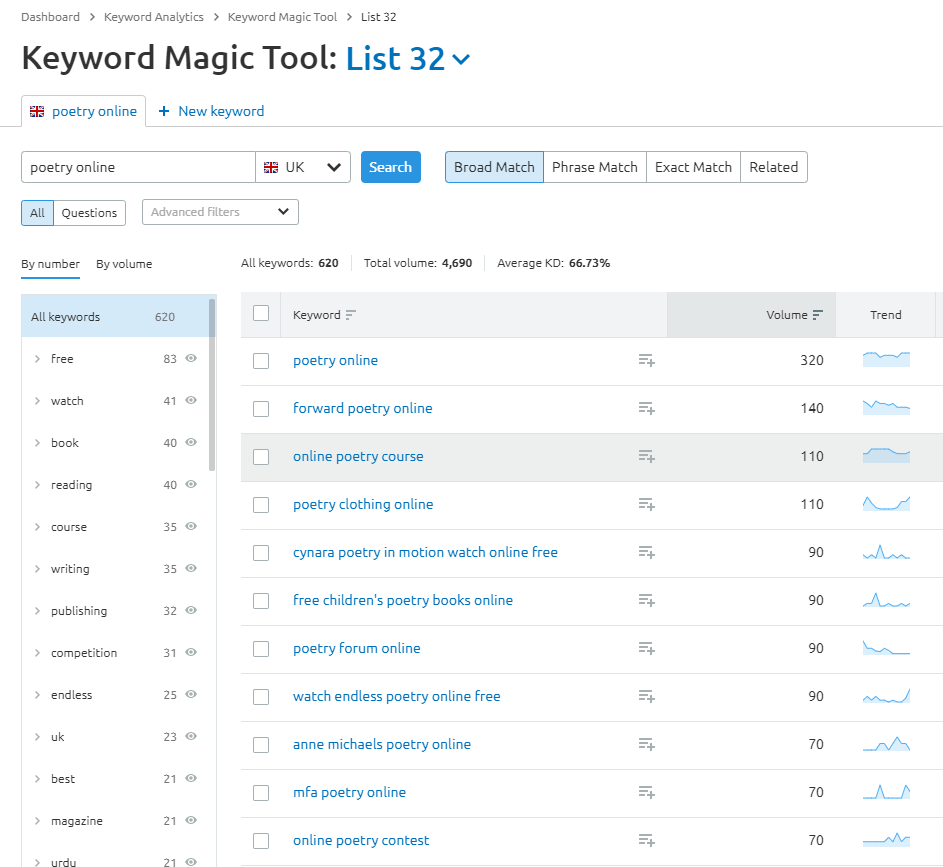
The first column shows the keyword; the second column shows the average number of monthly searches for a given keyword over a 12-month period; the third column shows the interest of searchers in a given keyword during the same 12-month period.
As you can see, the majority of these search queries are not suitable for my poem. I doubt that anybody typing in watch endless poetry online free is going to be interested in reading my SEO poetry. However, there are a few from this list that might be of interest to me:
 As I want to write my poem on the topic of SEO, I also carried out another search with SEO-related search queries:
As I want to write my poem on the topic of SEO, I also carried out another search with SEO-related search queries:
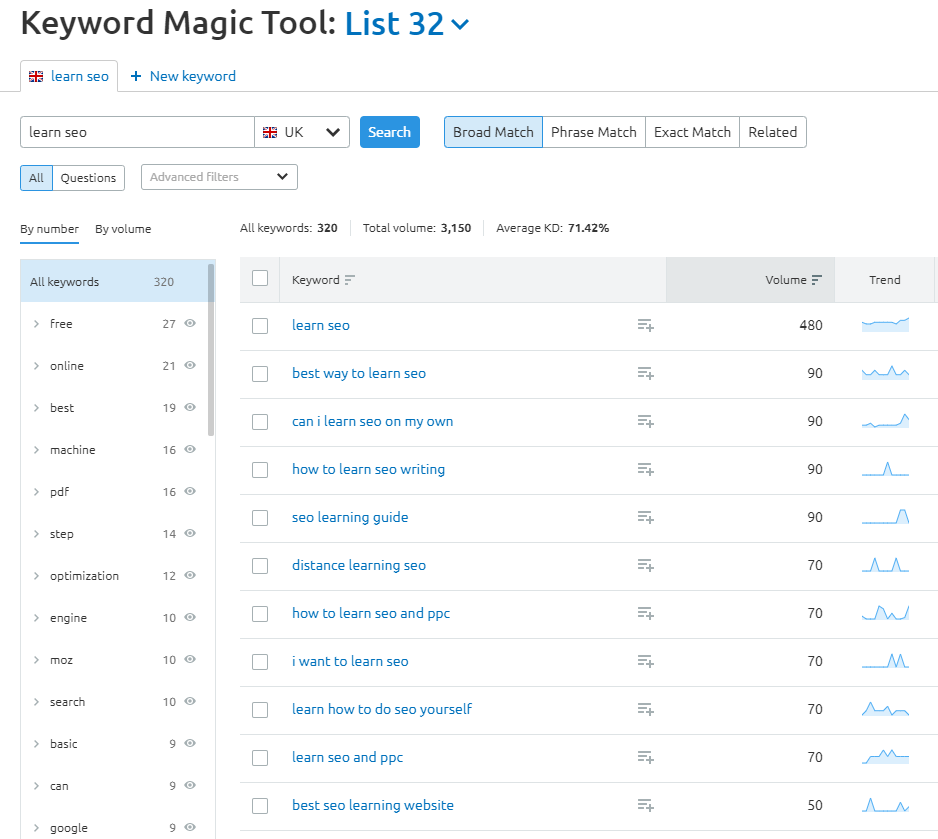 By picking and choosing the search queries that are relevant and have a decent search volume, I can collate a list of key phrases that will form the basis of my search intent modelling.
By picking and choosing the search queries that are relevant and have a decent search volume, I can collate a list of key phrases that will form the basis of my search intent modelling.
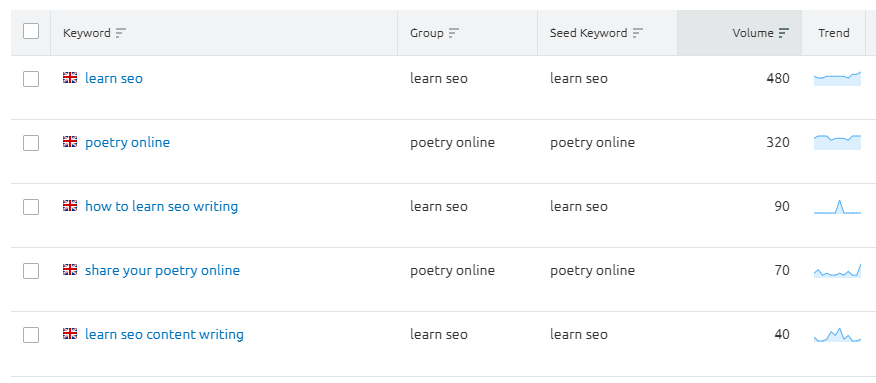 SEO Content Template
SEO Content Template
The next step is to paste my selection of keywords into SEMrush’s SEO Content Template tool. This gives me some specific insights into the parameters I need to set for myself when writing my poem:

1. The tool is suggesting that I enrich my text with a range of semantically related words. As search algorithms have improved, they have become better at identifying sense-based relationships between words in the same way that humans can.
For example, in the past a search engine would not have been able to recognise that the word dog relates to the words canine, pooch, spaniel, chihuahua, etc. Nowadays the Google algorithm is able to understand that these words are all semantically related and will therefore pull up results with relevant search intent indicators as well as those pages that contain the word dog.
2 . Based on the top 10 key phrases I entered, it is suggesting that I write a piece of content that is 1,757 words in length in order to rank above my rivals.
Having used this tool a fair amount, I have been surprised how this number changes depending on the topic of your key phrases. I have seen recommendations from 500 words all the way up to 2000 words. The number in this example is particularly high because the content that ranks for SEO-related key phrases tends to be long-form blog posts by other experts in the industry.
Needless to say, I am not going to write a poem that is 1,757 words long – I don’t think that any readers will have the patience for that (and it’s all about serving their desires, after all!). However, I can easily make up that word count with my commentary, which I will include on the same web page.
NB: I’m going to skip over the other two fields that you can see in this screenshot, purely for reasons of expediency. Gotta hit that 1,757-word quota!
I’m intrigued, I hear you mutter. Let us read the poem!
The Spider
It lurks.
Hunkering down in its nest
Of glittering binary,
Silken zeroes and silvery ones,
Gossamer sheer but strong as steel.
Then,
The vibration.
A tug, setting the search strings bouncing.
The spider raises its head,
Eight eyes blinking, pincers clicking,
Greedy for the query.
Fast
This crabbing beast
Scuttles along its web,
Its movement like poetry on lines of search silk,
Intent and aware.
The web
Is a cathedral of code,
A vast metropolitan map of stop signs, crossroads and
Serpentine site structure,
Tangled, twisting, towering, unnavigable?
Not for those who know.
Spider
Searches.
Skyscraping tower blocks of blog posts,
Topped with helipad landing pages,
Neon meta arrows calling “THIS WAY!”
Still
It searches.
Past the flashing carousels of product pages,
Barely a glance for the stuffed, graffiti-slick slums
And underground forums in the crypts and sewers
Where gaseous vents steam with sex and conspiracy.
Quick,
Brisk, slick with practice
It runs its skittering limbs over those lucky few,
The best, the brightest,
Luminescent with relevancy.
And there,
Just milliseconds later,
All lined up rank and file,
Spit and polish,
As if the chaos of the netherweb never existed at all,
Are the results.
Spider
Retreats, unbidden.
Back to its binary burrow,
A creature of code ready for its next query to
Recreate, content in its feast.
Use of key phrases and search intent indicators
You may have noticed that I didn’t manage to fit in all of the words and phrases that I had on my list – but that’s fine. Enriching has to come across as natural and unforced to the reader; cramming how to learn seo writing into this poem would, in my opinion, be inappropriate. I did, however, manage to include the following: 
Can you spot all of these? Some of them (marked red below) are sneakily hiding within other words that convey a different sense when read in the context of the poem:

 I’m particularly proud of sneaking SEO into the word ‘gaseous’. If you love to play with language in this way when you write content, I would recommend using a tool like the Word Finder on the Free Dictionary. It will give you a list of all of the words in the dictionary that contain a specific sequence of letters, which is very handy for fitting in difficult keywords:
I’m particularly proud of sneaking SEO into the word ‘gaseous’. If you love to play with language in this way when you write content, I would recommend using a tool like the Word Finder on the Free Dictionary. It will give you a list of all of the words in the dictionary that contain a specific sequence of letters, which is very handy for fitting in difficult keywords:
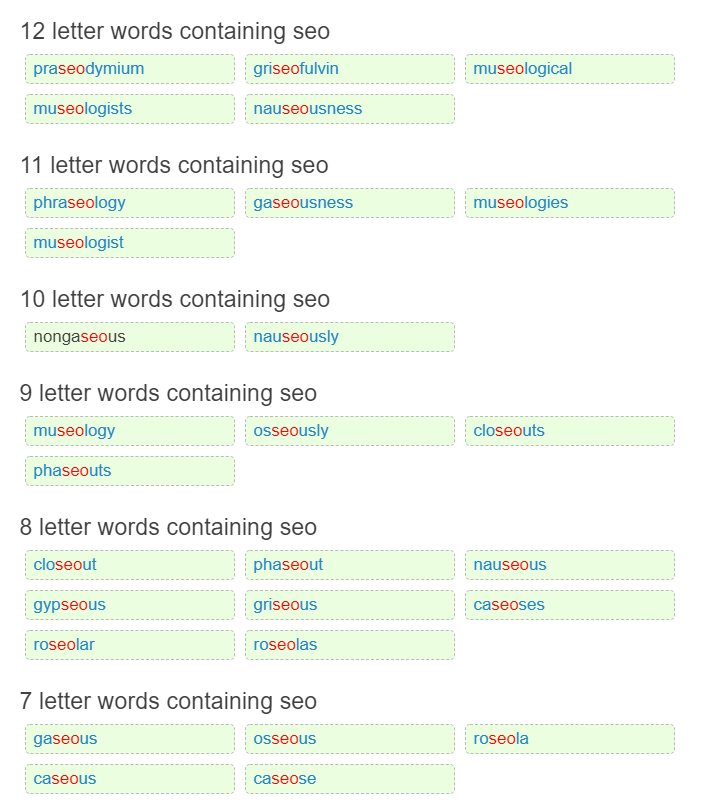 Use of imagery
Use of imagery
Incorporating many of these phrases became a lot easier when I realised that the language we use to describe SEO is so expressive. It’s common to talk about the Google spider crawling the web – there’s a ready-made poetic motif! We talk of mapping and navigating site structure, which is evocative of topography and construction. Even the term skyscraping is an SEO tactic.
A Meta Description Haiku
But I didn’t stop there…
One of the important elements of onsite optimisation is the meta description. This enticing snippet – which should be fewer than 160 characters including spaces and ideally contain a keyword – is your chance to convince search engine users to click on your result rather than anyone else’s in the SERPs.
Seeing as the rules for meta descriptions are so prescriptive, I decided to write a classic haiku for mine:

Notice how I got one of those tricky-to-integrate key phrases in there.
NB: If you came to this blog post via a search engine and decided to read it because of its intriguing meta description, let me know in the comments!
So How Did I Do?
Now that I’ve written this blog post, I can engage SEMrush’s SEO Writing Assistant. This is by far my favourite content tool – my team and I use it on every one of our online content pieces. It’s a Chrome extension that processes what you write in a Google Doc and gives you SEO recommendations based on what it knows of Google’s algorithm.
Here are my results for this blog post:
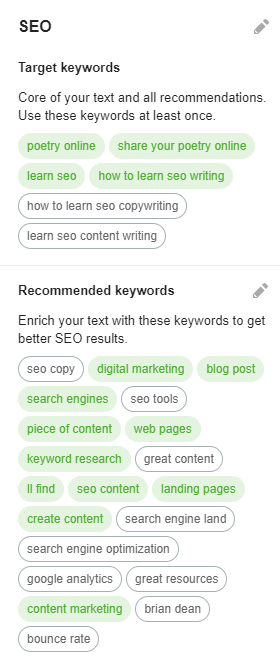
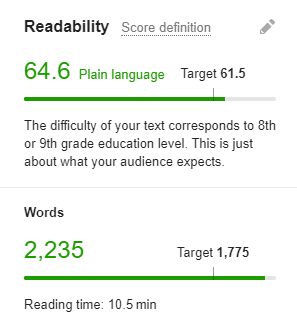 The result: In theory, this page has all the ingredients it needs to rank in search engines.
The result: In theory, this page has all the ingredients it needs to rank in search engines.